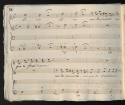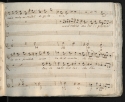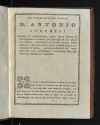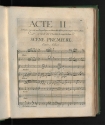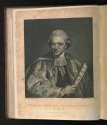La serva padrona: Intermezzo
Giovanni Battista Pergolesi. La serva padrona: Intermezzo. Paris: Aux Addresses Ordinaires et chez l’Editeur … Imprimé par Auguste de l’Orraine, ca. 1752. Engraved. Open to pp. 50-51, aria by Uberto: “Son imbrogliato, io già.”
La serva padrona was composed in 1733 by Giovanni Battista Pergolesi (1710-36) to a libretto by Gennaro Antonio Federico (fl. 1726-44). The comedy was created as an intermezzo (or entr’acte) to the composer’s tragedy Il prigioniero superbo for the Neapolitan Teatro San Bartolomeo, as part of the birthday celebrations for Empress Elisabeth Christina of Austria. Despite Pergolesi’s untimely death, the work continued to be performed on its own for the succeeding two decades (a highly unusual development) and there were more than 60 separate productions. In August 1752, the Italian troupe led by Eustachio Bambini performed Serva padrona in Paris, initiating the so-called “Querelle des Bouffons,” an academic polemic debating the relative merits of French and Italian music. No less than Jean-Jacques Rousseau proclaimed Pergolesi “divine” and modeled his own opera Le devin du village on La serva padrona.
Le devin du village
Jean-Jacques Rousseau. Le devin du village. Paris: Bureau du Journal de Musique, ca. 1770s. Engraved. Open to first page of music.
Inspired by the simple, “natural” style of Pergolesi’s La serva padrona, Le devin du village was composed by Rousseau to his own libretto in 1752 and performed for the royal court at Fontainebleau. The opera was an immediate success, deepening the musical and literary controversy surrounding the influence of Italian music in France. Le devin was subsequently performed at the Académie Royale de Musique, once the exclusive venue for French national opera, the tragédie lyrique. The opera was widely performed, even at the nuptials of Louis XVI and Marie Antoinette.
Solfeggi per il soprano
Leonardo Leo. Solfeggi per il soprano. Naples? ca. 1750. Manuscript. Open to title page.
Leonardo Leo (1694-1744) was trained at the renowned conservatory (music school) of Naples, the Santa Maria della Pietà dei Turchini. By 1714, Leo had graduated and rapidly established a reputation as a leading composer of opera as well as earning the post of vice-maestro of the Chapel Royal. Leo was also a gifted teacher, and his Solfeggio is traced to his academic responsibilities in the Neapolitan conservatories. Solfeggi were melodic studies, and conservatory students in Naples learned these melodies as the basis of a method for singing (hence the syllables ut-re-mi-fa-sol-la linked to degrees of a scale), to train their ears, and as a repository of exemplary tunes, which they could eventually emulate in their own music. The Neapolitan conservatory curriculum introduced students to the Solfeggio method in their first year; it was critical to their learning of melodic style in writing for voices. Leo utilized this collection of Solfeggi in his own teaching in Naples.
Duettini notturni con accompagnamento di clarinetti, corni, e fagotto
Gasparo Pacchierotti, former owner. Giovanni Paisiello. Duettini notturni con accompagnamento di clarinetti, corni, e fagotto. Naples, 1775. Manuscript. Open to pp. 18-19, “Ah voi di te erbose sponde la mia Nice dove ando?”
Given the preeminence of Italian stage drama in the eighteenth century and its utilization of the castrato voice (soprano and alto), many prominent divi were among the most famous and most highly compensated musicians in Europe. Gaspare Pacchierotti (1740-1821) initiated his career in the choir of the Cathedral of Venice, San Marco, before achieving fame as a primo uomo (leading man) in La Fenice (Venice) and then the Teatro di San Carlo (Naples), as well as the other principal theaters on the Italian peninsula. Pacchierotti also performed extensively in London, and his voice was praised by no less than the great historian Charles Burney and Lord Mount Edgcumbe, who stated, “he [was the] most perfect singer it ever fell to my lot to hear.” It was common for divi to compile collections of their favorite arias, as in the example on display.
Sei ariette (inedite), per voce sola con accomp[agnamen]to de piano forte
Girolamo Crescentini. Sei ariette (inedite), per voce sola con accomp[agnamen]to de piano forte. Naples: Giuseppe Girard, 1820. Engraved.
Among Pacchierotti’s contemporaries was the soprano castrato Girolamo Crescentini (1762-1746), who was called the “Italian Orpheus.” Crescentini’s career began late for a castrato, yet by the decade of the 1780s, he had established himself as a primo uomo in Naples, collaborating with the leading composers of the era: Guglielmi, Cimarosa, and Paisiello, who composed roles expressly for the singer. Crescentini also passed four years as director of the Teatro Nacional de São Carlos in Lisbon and eventually was appointed by Napoleon Bonaparte as singing teacher of the Imperial Family. Crescentini was also a gifted composer, as evidenced by this intimate collection of arias for soprano and piano accompaniment.
Duetti a due soprani
Francesco Durante. Duetti a due soprani. Naples, ca. 1740-1790. Manuscript. Open to cantata Number IV, “Alme, voi che provaste.”
Francesco Durante (1684-1755), like many of his generation, was educated in the renowned conservatories of Naples and is closely associated with the city. Although he is known today primarily for his operas, Durante composed a large repertory of sacred and instrumental music. The manuscript on display undoubtedly derives from his own teaching in the Neapolitan conservatories. Durante utilized the cantatas of the celebrated composer Alessandro Scarlatti as a starting point, stripping away the accompaniment and composing a new line as the basis for instructing students in vocal style. This method posits Scarlatti’s style as an exemplar of vocal writing, while also encouraging students to develop their own approach.
La pietà d’amore: Dramma messo in musica
Giuseppe Millico. La pietà d’amore: Dramma messo in musica. Naples: Giuseppe-Maria Porcelli, 1782. Letterpress preliminaries, with engraved music. Open to dedication, outlining Millico’s aesthetic principles, sig. *2.
Giuseppe Millico (1737-1802), a soprano castrato and composer who trained in Naples, had an international career extending as far as St. Petersburg, Russia. Millico collaborated often with the composer Christoph Willibald Gluck and librettist Raniero de’ Calzabigi, who innovated an influential reform of tragic opera in the late eighteenth century. Millico was also respected as a voice teacher (his students included Maria Teresa di Borbone and Lady Emma Hamilton) and increasingly turned to composition later in life. His opera La pietà d’amore was composed for Naples in 1782 and directly influenced by the “reform” works of Gluck and Calzabigi. It remains one of the few opera scores to have been printed in late eighteenth-century Naples. Reflecting his influences, the score includes a preface outlining Millico’s aesthetic principles for stage drama.
Lo sposo burlato / Didon: Tragédie en trois actes
Niccolò Piccinni. Lo sposo burlato. Paris? ca. 1780-1790. Manuscript. In a bound volume containing scores of arias, scenes, and duets from Piccinni’s operas, some with the composer’s autograph corrections. Open to an aria, pp. 6-7.
Niccolò Piccinni. Didon: Tragédie en trois actes. Paris: Chez le Suisse de l’Hotel de Noailles, [1784]. Engraved. Signed by Piccinni on title page. Open to an air for Enée, Act II, Scene 1, p. 95.
Niccolò Piccinni (1728-1800) was a prolific and widely acclaimed composer of opera, in virtually every contemporary style. Beginning in Naples in the 1750s, (where he was educated), Piccinni rapidly established a reputation as a composer of comic and tragic works which were circulated throughout the Italian peninsula, England, France, Germany and Russia. Piccinni’s Lo sposo burlato (1769) is an intermezzo, whose quotidian characters and vibrant melodies are indicative of the Italian comic tradition. In 1776, Piccinni was enticed to relocate to Paris, reigniting the “Querelle des Bouffons,” this time with Christoph Willibald Gluck as antagonist. Piccinni’s Didon is a tragédie lyrique based on Virgil’s Aeneid with a libretto by Jean-François Marmontel. This opera was highly successful and underlined Piccinni’s ability to master French dramatic and musical idioms.
Solos for a violin with a thorough bass for the harpsichord or bass violin / A general history of music, from the earliest ages to the present period
Michele Mascitti. Solos for a violin with a thorough bass for the harpsichord or bass violin. London: I. Walsh and I. Hare, ca. 1712. Engraved. Open to title page, with Charles Burney’s initials at upper right.
Charles Burney. A general history of music, from the earliest ages to the present period. London: for the author, 1776-1789. Open to Volume 4 title page and engraved frontispiece portrait of Burney after Sir Joshua Reynolds.
Michele Mascitti (1663/64-1760) was a virtuoso violinist and composer, trained by his uncle Pietro Marchitelli in Naples. Mascitti began his career in the Chapel Royal; however, he soon embarked on professional engagements throughout Italy, Germany, and the Netherlands. Mascitti settled in Paris in 1704, where he entered the service of the influential Duke of Orléans and gained access to the royal court. His violin sonatas were hailed as models of Italian instrumental music and circulated widely in France, England and the Low Countries. The copy on display was once owned by the music historian Charles Burney (1726-1814), whose volume The Present State of Music in France and Italy (1772) remains among the seminal histories of eighteenth-century music. Burney traveled extensively for this history, meeting many of the musicians profiled and writing with keen insight about contemporary music, musicians, and practices.
Il matrimonio segreto: Dramma giocoso in due atti
Domenico Cimarosa. Il matrimonio segreto: Dramma giocoso in due atti. Paris: Imbault, [1814]. Engraved. From the library of Camille Saint-Saëns. Volume 1: Open to title page. Volume 2: Open to the quintet “Deh, lasciate” in Act II, pp. 358-359.
Domenico Cimarosa (1749-1801) was a central figure in late eighteenth-century operatic practices. Trained in the Neapolitan conservatory Santa Maria di Loreto, Cimarosa established a considerable reputation as a composer of comic opera. His operas were performed widely, and in 1787 he was appointed as maestro di cappella at the court of Catherine II in St. Petersburg. Il matrimonio segreto (based on the libretto by Giovanni Bertati) was premiered in Vienna (1792) and it is considered a masterpiece of Italian comic style. The Austrian Emperor Leopold II attended the premiere and ordered a private performance of the opera immediately following its initial performance. The opera was an international sensation and it was presented in Leipzig, Dresden, Berlin, Paris, Milan, Florence, Naples, Turin, Madrid and Lisbon, in the following two years after its debut, achieving an unprecedented circulation. The opera is currently the basis for an international collaboration of scholars (Michele Calella, Guido Olivieri, and Federico Gon) to produce a critical edition to be published by Bärenreiter Press.
Curated by Anthony R. DelDonna, Professor of Musicology, Department of Performing Arts, with assistance from John A. Buchtel and Stephanie Hughes.
This display is presented in conjunction with a Friday Music Series performance by Modern Musick, McNeir Hall, New North, Friday, September 22, 2017 at 1:15 p.m. The concert will be preceded a lecture in the Booth Family Center for Special Collections by Guido Olivieri (University of Texas at Austin): “A Neapolitan in Paris: The Extraordinary Career of Michele Mascitti” at 10:30 am.
The Leon Robbin Gallery, dedicated to displaying the treasures of the Leon Robbin Collection of Music Manuscripts and Letters of Composers, was generously funded by an endowment created by the late Leon Robbin L’22. All items on display were acquired on the Leon Robbin Endowment Fund.








